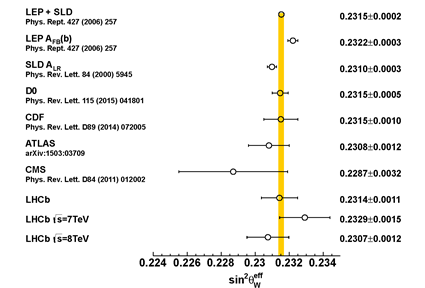[ sin2θWeff = 0.23142±0.00073(stat)±0.00052(sys)±0.00056(theory) ]
The LHCb collaboration has submitted a paper based on run 1 data which reports the measurement of a fundamental parameter of the Standard Model (SM), the electroweak mixing angle, θW. This parameter quantifies the relative strengths of electromagnetism and the weak force. It is, therefore, an important experimental challenge to measure it.
The squared sine function of the electroweak mixing angle sin2θWeff was precisely measured by the experiments at the Large Electron-Positron Collider (LEP) in the 1990s. The electrons and positrons were collided at the energy of about 91 GeV at which the Z boson resonance was formed. The Z bosons than decayed into pairs of leptons (e+e–, μ+μ–, τ+,τ–) or pairs of quarks. By determining the electric charge and direction of these decaying particles a quantity called the “forward-backward asymmetry” was measured, and then used to calculate the value of sin2θWeff. The forward-backward asymmetry is related to how often the produced matter particle travels in a similar (“forward”) direction as the incoming matter particle involved in the collision. An important measurement was made also at another electron-positron collider SLAC Linear Collider (SLC) with the detector SLD. The sin2θWeff parameter was determined from the analysis of a so called left-right asymmetry obtained by counting the difference in number of Z bosons produced with two opposite (left and right) spin orientation of colliding electrons using the longitudinally polarized SLC electron beam. The measurement requires no detailed final-state identification. It turned out that the most precise measurements of sin2θWeff, the LEP forward-backward b quark asymmetry (AFB(b)) and the SLD left-right asymmetry (ALR), differed by 3.2σ (see a figure from the LEP-SLD electroweak report in which all the details of measurements are explained). This 3.2σ LEP-SLD puzzle has been interpreted by some commentators as an effect driven by new physics. It is a very interesting challenge for measurements at other particle colliders to resolve this puzzle.
Measurements of sin2θWeff have continued at the Tevatron at Fermilab and LHC at CERN. The task is, however, more difficult than at an e+e– collider. The parton (quark and antiquark) distributions inside proton need to be known precisely. At the LHC the Z bosons used in this analysis are produced mainly in the collisions of (valence) quarks with high momentum and (sea) antiquarks with low momentum. The Z bosons then decay into a pair of electrons or muons. The LHCb geometrical acceptance is ideal for this measurement. The incoming quark direction, needed to define the sign of the asymmetry, can be identified correctly 90% of the time.
LHCb has measured the forward-backward asymmetry AFB in the angular distribution of muons in dimuon final states as a function of the dimuon mass both at 7 and 8 TeV centre-of-mass energies. An example of the angular asymmetry, for data taken at 8 TeV, is shown in the left image as measurement points compared to a (shaded) Standard Model prediction. The LHCb sin2θWeff result is in very good agreement with the other determinations from LEP, SLD, Tevatron and LHC, and is one of the most precise measurements obtained at a hadron collider. The precision of the measurement is not yet sufficient to shed light on the interpretation of the 3.2σ LEP-SLD puzzle as shown in the right image. However, it is very promising and shows that with the additional data, expected in LHC run 2 and beyond, a very interesting determination of this fundamental parameter should be possible.
Read more in the LHCb publication, in the CERN Courier article and in the LHCb seminar at CERN.


